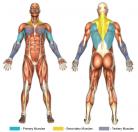Close Grip Reverse Pull-Up / Reverse Chin-Up (Calisthenics)
- Face the raised pull-up/chin-up bar, and, if necessary (due to bar height), either using a small stool or jumping, grab the bar in an underhand fashion (palms facing the body) with your hands centered at your body about 3-4 inches apart.
- Depending on the height of the bar (and your height), you should now be hanging or your feet should be slightly touching the ground. If they are touching the ground, you may have to position the feet slightly in front of the body to ensure they do not touch on the negative portion of the close grip reverse pull-ups / reverse chin-ups.
- Inhale and pull the chest to the bar, keeping the body upright and puffing out the chest. The elbows should be kept in front of the body, not off to the sides.
- Hold the up position for a moment, feeling the biceps flexing.
- Slowly lower the body down to a near starting position, letting the arms extend to a nearly straight position. Exhale as the negative motion is performed.
- Repeat steps 3-5 for as many repetitions as are desired.
The primary muscles worked by reverse pull-ups are the latissimus dorsi, teres major and biceps. Due to the close grip nature of the exercise, the outer head of the biceps brachii is emphasized similar to the hand position when performing barbell curls. Do not be fooled though, while the biceps are targeted more during this close grip reverse pull-ups / reverse chin-ups, the back is still utilized a great deal.
If back emphasis is desired (whether it be to work at a v-taper appearance or overall back mass), traditional pull-ups are preferred. See "Pull-Up / Chin-Up". The wider grip allowed by traditional pull-ups promotes the width of the upper portion of the lats (thus creating or enhancing the often desired v-taper appearance).How to make close grip reverse pull-ups easier:
Pull-ups are prime among back exercises, however, they are not a particularly easy exercise, and as such many people may not be able to perform them. This is okay because most gyms have a machine that provides aid for this very problem. The machine is an assisted pull-up/dip machine. It works by removing part of one's body weight so as to make the pull-ups doable. Specifically, a pad, which is connected through a cable to weighted plates (which is set to the lifter's choosing), goes beneath the knees and removes a percentage of weight from each pull-up, thereby making the lift possible.
How to make close grip reverse pull-ups more difficult:
For those that desire a greater challenge (i.e. a more intense lift), a weighted (dip) belt may be used to add weight to the lifter's weight. In this manner, the exercise maybe be made to be as difficult as one desires; one could add 5 pounds or 150 pounds to their body weight, for example. See "Dip Belt" for a picture and description of this equipment.
The hand positioning of this exercise is what makes it unique, be sure to keep your hands nice and close for proper bicep emphasis.
Also, be sure to check that before you lift yourself up, there are no obstructions above the head. Due to the elbows being positioned in front of the body, the torso is lifted a substantial amount higher than traditional pull-ups / chin-ups.





